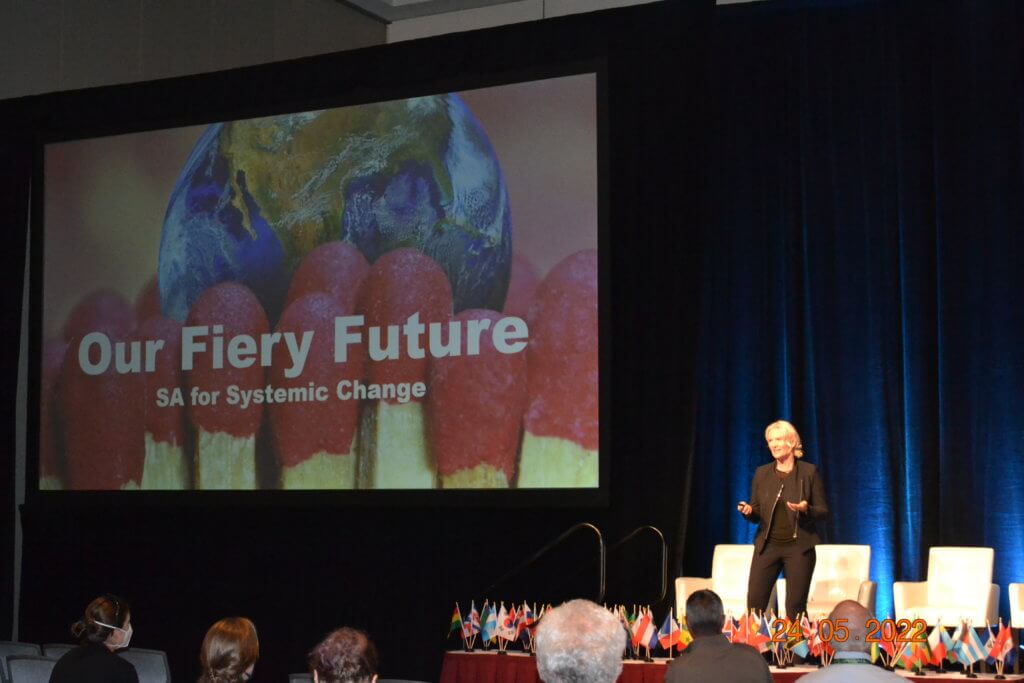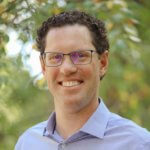OUR FIERY FUTURE
HOW WE CAN WE FACE AND CHANGE OUR FUTURE WITH WILDFIRE
BY LUCIAN DEATON
Note: Registrants can view Our Fiery Future by logging into the Pheedloop link on the Fire & Climate Pasadena conference website.
At Fire & Climate 2022 Conference in Pasadena, Kate Dargan – founder of Intterra, former California state fire marshal, and former assistant director for disaster preparedness and response in The White House Office of Science and Technology Policy, posed a question to a packed hall: What is our fiery future and what can you do today to impact our future to come?
Dargan said fire stewardship is at the core of the IAWF and noted that the audience was positioned at the tip of the spear for the required effort.
Setting the scene, Dargan explained that we are entering a dynamic fire environment, and illustrated this as a “J curve” that is quickly leaving the relatively stable and comparatively flat environment of the past to the sharp upturn we are seeing now and face in the future as well. She used this to also show what actions we should take now to confront this developing risk with similar vigor.
Dargan leveled with the audience early, explaining that she would talk about the real stuff, and that it would be “dark.” Yet, the presentation illuminated both the future and the choices we have to confront the darkness.
Dargan framed this changing environment in four distinct periods spanning from the present to beyond 2050; she challenged the audience to consider not only how to approach these times, but also how their actions would need to keep up to achieve the future they most wanted. Providing perspective to the audience, Dargan thoughtfully explained, “You need to plan for the fire you are going to have.”

that need to be made to illiminate the future. Photo by Mikel Robinson.
2020-2030: SHOCK AND PLANNING
Dargan explained that our near future will be a time of recognition and initial steps; this is when wildfire will become “an official problem.” Dargan challenged the audience to appreciate that our collective relationship with fire will have to change as tinder-dry landscapes burn and our response system is overwhelmed. The current reality of large fires, community destruction and ever-toppling records will set the tone for this period.
2030-2040: THE ANGRY YEARS
This not-too-distant future is when climate change “will sit in everybody’s house” becoming a communal reality and will require adaptation and mitigation. Dargan suggested this time period may be one of stricter land use regulations, home development guidelines, and even community rebuilding considerations. It will also be a period when the forests of the Northern California watersheds will reburn. When such valuable landscapes are impacted, Dargan noted that the challenging future will be as much about wildfire as it is about water availability.
2040-2050: THE SAD YEARS
Building upon this progression of wildfire and its impacts, Dargan explained that we will find ourselves stuck in a future during which mega fires are normal. No longer will the fires be “unprecedented” or the stuff of shocked media headlines. Dargan also suggested that a rural-urban divide about the risk and response to wildfire would become extreme. The debate about costs and who should pay will dominate the discussion, Dargan said. While home insurability has a built-in system elasticity, Dargan said that during the sad years, this insurability challenge will find itself in true crisis.
2050 AND BEYOND: IT’S UP TO US
As this future arrives, Dargan said, water issues will dominate the discussion. There will be winners and losers in communities across the western United States, Dargan said, and we will face a social tipping point in need of positive attention. Hard decisions will have to be made on climate choices to save our future beyond this period.
Turning from the dark, Dargan stressed that we need will to help each other more in this distant future and be part of the necessary change. A major lesson to the audience was in Dargan’s explanation that urgency and humility are needed to make the future better. Collaboration among agencies and companies on grants and available data will be needed to approach the issue holistically. Unified command in federal agency land management will be required to muster the focus needed, Dargan said. And a national consensus will be necessary to address the challenge and win the hearts and minds of a skeptical public for such dramatic but necessary change
Dargan explained that we are the lighthouses who can guide change and encouraged everyone to find consensus and build consortiums today. And, in a nod to the current reality, Dargan applauded the work of Oregon state agencies and local groups positively tackling their wildfire risk saying that “they are nailing it!”
Dargan closed by offering a proposal: a 50-year plan, an approach that sets goals, objectives, and uses clear messaging to develop a vision of where we all want to be in a world of wildfires. Dargan said such a plan’s first 25 years should be broken into five-year cycles, and that the first 10 years must be strongly funded. Dargen felt the plan requires a non-pyramidal approach, and maybe even new national institutions to guide its success; and requires international associations to build the change and lay it in front of governments.
While Dargan stressed that we are not yet at the new normal that is coming, every moment of our present counts along this path and she wanted the audience in Pasadena – and everyone else – to know that we are the change that is needed.
ABOUT THE AUTHOR

Lucian Deaton is a program and policy strategist who has worked for the last 20 years on community safety and advocacy. He is the senior digital marketing manager for Technoslyva, which focuses on operationalizing wildfire science. Previously, Lucian managed the Firewise USA® Program and its international outreach for adaptation by valued international partners. He also managed NFPA’s Outthink Wildfire initiative, advancing domestic policy for community risk reduction. Formerly, Lucian managed the IAFC Ready, Set, Go! Program and was a lobbyist representing public safety issues before the U.S. Congress and federal agencies. Lucian holds a Masters of Urban and Regional Planning and a Masters of Natural Resources degrees from Virginia Tech and lives in Denver, CO.
